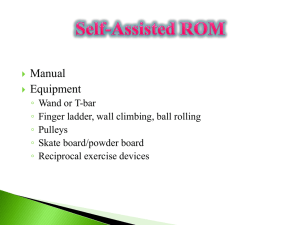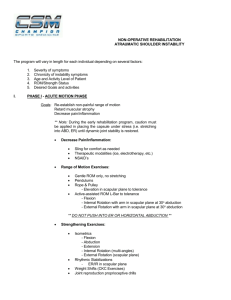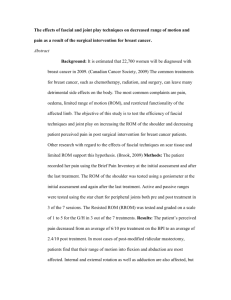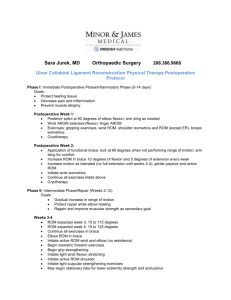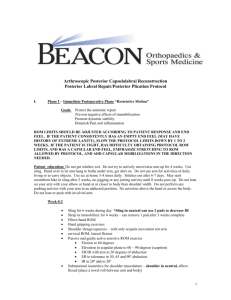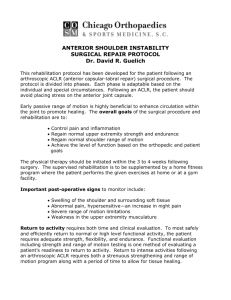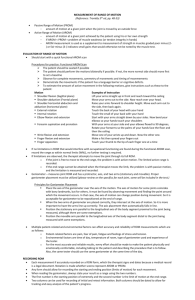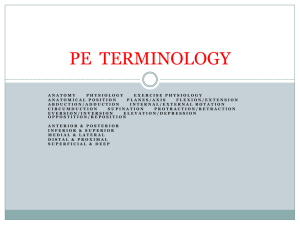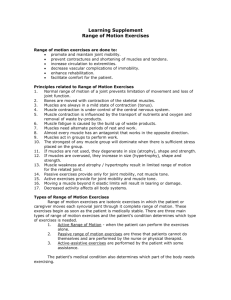Arthroscopic Anterior Capsulolabral Reconstruction
advertisement
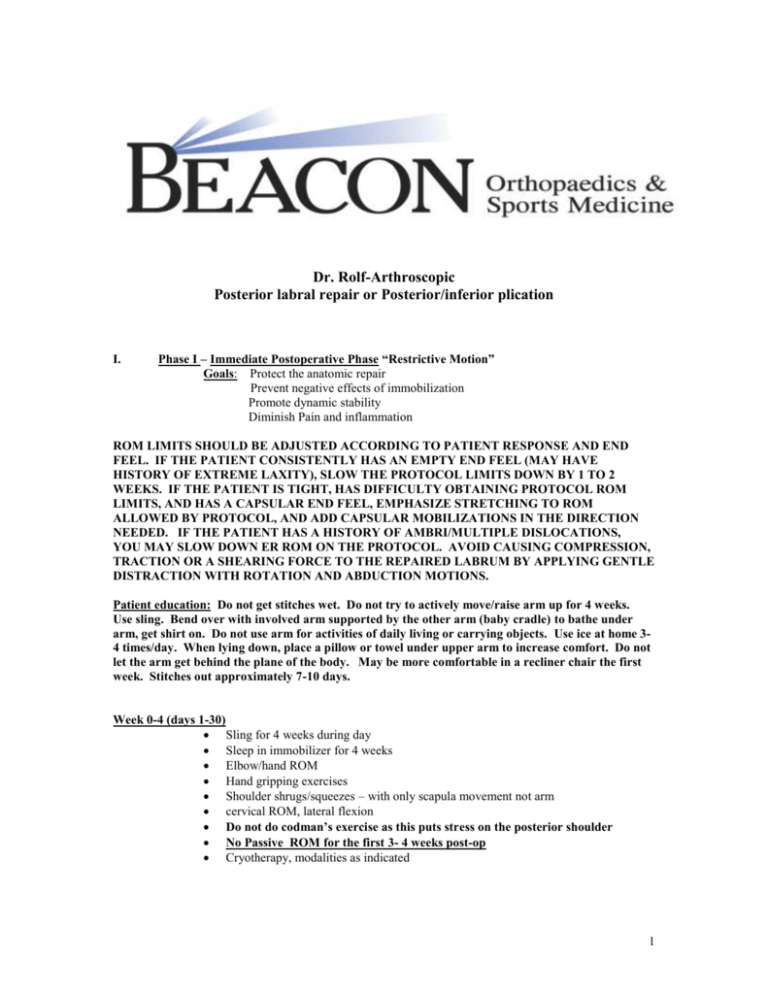
Dr. Rolf-Arthroscopic Posterior labral repair or Posterior/inferior plication I. Phase I – Immediate Postoperative Phase “Restrictive Motion” Goals: Protect the anatomic repair Prevent negative effects of immobilization Promote dynamic stability Diminish Pain and inflammation ROM LIMITS SHOULD BE ADJUSTED ACCORDING TO PATIENT RESPONSE AND END FEEL. IF THE PATIENT CONSISTENTLY HAS AN EMPTY END FEEL (MAY HAVE HISTORY OF EXTREME LAXITY), SLOW THE PROTOCOL LIMITS DOWN BY 1 TO 2 WEEKS. IF THE PATIENT IS TIGHT, HAS DIFFICULTY OBTAINING PROTOCOL ROM LIMITS, AND HAS A CAPSULAR END FEEL, EMPHASIZE STRETCHING TO ROM ALLOWED BY PROTOCOL, AND ADD CAPSULAR MOBILIZATIONS IN THE DIRECTION NEEDED. IF THE PATIENT HAS A HISTORY OF AMBRI/MULTIPLE DISLOCATIONS, YOU MAY SLOW DOWN ER ROM ON THE PROTOCOL. AVOID CAUSING COMPRESSION, TRACTION OR A SHEARING FORCE TO THE REPAIRED LABRUM BY APPLYING GENTLE DISTRACTION WITH ROTATION AND ABDUCTION MOTIONS. Patient education: Do not get stitches wet. Do not try to actively move/raise arm up for 4 weeks. Use sling. Bend over with involved arm supported by the other arm (baby cradle) to bathe under arm, get shirt on. Do not use arm for activities of daily living or carrying objects. Use ice at home 34 times/day. When lying down, place a pillow or towel under upper arm to increase comfort. Do not let the arm get behind the plane of the body. May be more comfortable in a recliner chair the first week. Stitches out approximately 7-10 days. Week 0-4 (days 1-30) Sling for 4 weeks during day Sleep in immobilizer for 4 weeks Elbow/hand ROM Hand gripping exercises Shoulder shrugs/squeezes – with only scapula movement not arm cervical ROM, lateral flexion Do not do codman’s exercise as this puts stress on the posterior shoulder No Passive ROM for the first 3- 4 weeks post-op Cryotherapy, modalities as indicated 1 Weeks 3-4 • Discontinue use of sling at 4 weeks • Continue gentle PROM/AAROM exercises (Rate of progression based on patient’s tolerance) o Gentle passive Flexion and elevation in the plane of the scapula up to 120 degrees. (gentle passive motion but do not stretch or push flexion) o Abduction to 75-85° o ER in scapular plane to 45-50° o Gentle IR in scapular plane to 10-15° (gentle passive motion but do not stretch or push IR) Avoid horizontal adduction • Initiate rhythmic stabilization drills within above ROM • Initiate proprioceptive training within above ROM • Begin Shoulder isometrics • Continue use of cryotherapy, modalities as indicated Weeks 5-6 • Begin AROM of shoulder (all planes, gravity eliminated positions then gravity resisted position once adequate mechanics): • Gradually improve PROM and AROM o Flexion and elevation in the plane of the scapula to135-145 degrees o Abduction to 135° o External rotation 45-50° at 45° abduction o Internal rotation 25-30° at 45° abduction o Extension to tolerance • May initiate gentle stretching exercises • Gentle Proprioceptive Neuromuscular Facilitation (PNF) manual resistance • Initiate prone exercise program for periscapular musculature • Begin AROM elbow flexion and extension Phase II: Intermediate Phase-Moderate Protection Phase (Weeks 7-14) Goals • Gradually restore full AROM and PROM (week 10) • Preserve the integrity of the surgical repair • Restore muscular strength and balance Weeks 7-9 • Gradually progress P/AROM o Flexion, elevation in the plane of the scapula, and abduction to 155° o External rotation 70-80° at 90° abduction o Internal rotation 40-45° at 90° abduction 2 o Extension to tolerance • Begin isotonic rotator cuff, periscapular, and shoulder strengthening program • Continue PNF strengthening • Initiate "Thrower's Ten" program Weeks 10-12 • Progress passive and active ER to 90 degrees and IR to 50-55 degrees if tolerable • Progress shoulder isotonic strengthening exercises as above • Continue all stretching exercises as need to maintain ROM. • Progress ROM to functional demands (i.e., overhead athlete) Criteria for Progression to Phase III • Full non painful ROM • Good stability • Muscular strength 4/5 or better • No pain or tenderness Phase III: Minimal Protection Phase (weeks 14-20) Goals • Establish and maintain full ROM • Improve muscular strength, power, and endurance • Gradually initiate functional exercises Weeks 14-16 • Continue all stretching exercises (capsular stretches) • Maintain thrower's motion (especially ER) • Continue rotator cuff, periscapular, and shoulder strengthening exercises • PNF manual resistance • Endurance training • Initiate light plyometric program • Restricted sports activities (light swimming, half golf swings) Weeks 16-20 • Continue all exercises listed above • Continue all stretching Generally no return to contact sports for at least 6 months Please call Dr. Rolf with any questions! Beacon Orthopaedics and Sports Medicine Summit Woods (513)389-3666 West (513)354-7777 3 Updated 2/12/2015 4
